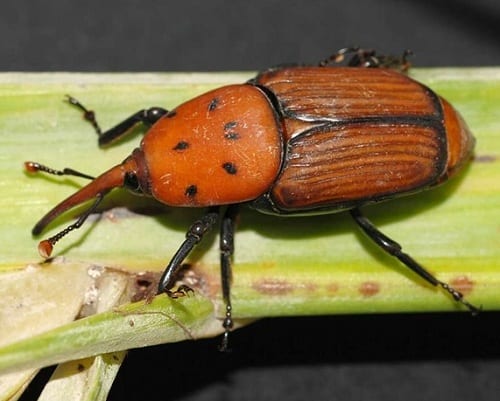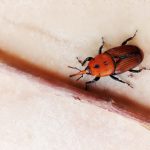THE University of Cordoba has developed a pesticide that could ward off the palm tree-killing Red Palm Weevil.
A research group found trees could be saved if pesticides are injected into the stricken tree early enough.
An Andalucian company has patented the formula, which could prove to be a match for the beetle that has wrought devastation in palm plantations across southern Spain for over 20 years.
As many as 20,000 palm trees in Andalucia alone have been killed by the beetle since its arrival, leading to an attempted intervention by the EU.
For more long-term cases, where the weevil has gained a foothold, the university in experimenting using a fungus which is toxic to the beetle, though at present the treatment may be too expensive for use by Town Halls.










use zotal,a spanish type of jeyes fluid disinfectant and mix with about 6o litres of water.pour into the centre crown every 3 weeks in the summer less in winter or rainy weather.be aware every trim or cutting attracts the bugs….anti ant powder and sprays help a lot as well….best of luck all!
What exactly type Zotal G or XXI ?
Thanks from France
This is an interesting article.
pg I am unsure that Zotal/Jeyes Fluid works on its own. Three years ago in my area of Spain it was lauded as a cure, but since then no one had supported the suggestion. My neighbour tried it and lost his tree.
I have 10 Phoenix Canariensis, and lost one three years ago, and suspected that three more were infected. I have since used Imidacloprid, about 5ml per tree in 10 litres of water. I drilled the suspect trees about 20cm deep near the top of the trunk and pressure spray into the tree. I also Spray the crown and trunk of all the palms and also pore about 10 litres of the diluted imidacloprid into the ground around the tree. So far I have not lost another palm, including the suspect ones.
I do use zotal, as a paint mixed with Imidacloprid and water, on the exposed cut palm fronds, hoping the smell of the zotal masks the palm smell.
On average over the past three years, I have found about 9 dead adult beetles around the palm trees per year.
Imidacloprid is a systemic insecticide that lasts about 2 months within the palm. I treat very 6 weeks between March and November.
So far, so good, hope everyone else manages to keep their palms.
Hello,
Read this with insect as I want to protect the palm I have and plant more to make up for all the palms near me that have gone. I am in southern Portugal. How is the treatment with imidacloprid going? I notice your post was just over a year ago.
Thanks for any information you can give.
Ian Chapman
Hi Ian
All well up to a couple of months ago, when one of my 3 suspect palms has been attacked again. I had stopped injecting the palm as I had concluded it showed no signs of attack, so only used surface spraying plus root insecticide. The other palms are OK, but this one has been attacked at the top of the crown in the centre. In hindsight I should have continued to inject insecticide, though the tree has grown another metre or so over the last year. I am now flooding the top of the tree with insecticide and will drill all my larger palms this year as I am guessing the application to the roots does not get to the top of the palm when it has a trunk of nearly 2 metres.
Will keep you posted. I guess the remainder of the palms look healthy, so the treatments are mostly working. The beatle is still very active on the few remaining palms in our neighbourhood.
best of luck with your palms
“In January 2013, the European Food Safety Authority stated that neonicotinoids pose an unacceptably high risk to bees, and that the industry-sponsored science upon which regulatory agencies’ claims of safety have relied, may be flawed, or even deceptive.” Wikipedia
We have just lost a phoenix canariensis in our villa on Kefalonia in the Greek Ionian Islands. My concern is how these weevil affect any other plants. Do they attack anything else as i have mulberry trees and many shrubs? Can anyone tell me whether chain sawing the tree at root level will be sufficient to deter these bugs or what other action i should take to protect my garden. Would be grateful if anyone with knowledge could e mail advice. Thanks